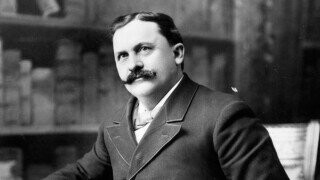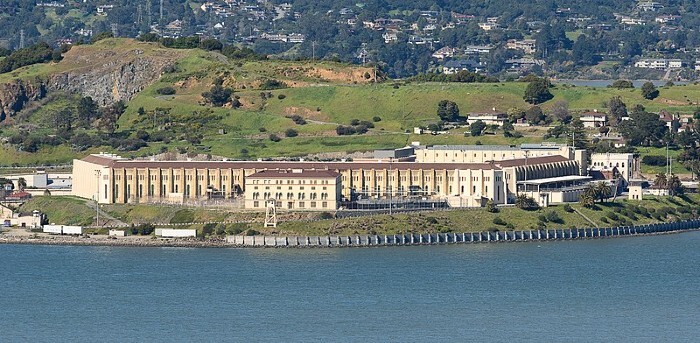The Bonkers Life of Griffith J. Griffith, California's Wildest Tycoon

If you’ve ever been to Griffith Park or the Griffith Observatory in Los Angeles, which you definitely have if you’ve ever been to Los Angeles, you’re aware that some guy named Griffith was a big deal in the city. You’re probably not aware, however, of how he got that way, which involved a mining empire, ostriches, attempted murder, and a handful of legal precedents.
He Was Raised in Wales

Griffith Jenkins Griffith -- which was, yes, his real legal birth name -- was born and raised in Wales for the first 15 years of his life before immigrating to the U.S. and settling in California in the mid 1800s. That means, in all likelihood, he had that amazing Christian Bale accent, which makes the rest of this story all the better.
He Was a Journalist

The man who became one of the wealthiest in California at the time started out in the notoriously low-paid field of journalism, working for the Alta California newspaper in San Francisco in the 1870s. Back in Wales, his father had worked in mines, which made him a natural fit to cover the state’s booming mine trade. It turned out to be a little too good of a fit.
He Made His Fortune in Mining
Not long after he began reporting on mining for the newspaper, Griffith realized journalism was dumb and mining could make you a lot of money. With the knowledge he’d gained of the mining industry, he styled himself as a high-priced consultant, selling trade secrets to investors. This is technically insider trading, but there were no laws in 19th-century California, so that wasn’t illegal yet. He invested his fees back into the mining industry, and by the time he was 32, he was a millionaire.
He Called Himself “the Colonel”

Millions in pocket, Griffith set out to adopt the eccentricities fitting of his station. In addition to the luxurious overcoats and gold cane that became his uniform, he began referring to himself as “the Colonel,” even though no one could find any record of military service beyond a brief stint in the Coast Guard, where he only rose to the rank of major in rifle practice.
He Had an Ostrich Farm

The original purpose of the land Griffith Park occupies now was to capitalize on the ostrich craze of the late 1800s. Griffith kept ostriches to sell their feathers, which were popular in women’s fashion at the time, as well as attract tourists who liked to feed the animals whole oranges and watch them slide down their long, skinny necks. Hey, there wasn’t much to do in the 19th century.
The Griffith Park Land Just Wasn’t Profitable

After everyone realized ostriches were just mildly silly-looking birds, Griffith’s farm closed down, and he couldn’t find any other use for it. He tried to sell it, but he couldn’t find any buyers, so he donated it to the city as a Christmas present. He made a lot of noise about the virtue of public parks, but the truth is that it just wasn’t making him any money and he didn’t want it anymore. It was like having a big, ugly, useless hunk of furniture in your living room, except on a millionaire scale.
He Thought His Wife (and the Pope) Was Trying to Kill Him

In 1887, Griffith married socialite Mary Agnes Christina Mesmer, and they had a son the following year, but the happy times were not to last. Griffith soon descended in the Trainspotting falling-through-the-carpet sense of the word into alcoholism and paranoia, convinced that his Catholic wife was conspiring with the Pope to poison him. You know, just Protestant things.
He Tried to Kill His Wife

Finally, during a stay at the Arcadia Hotel in September 1903, Griffith confronted his wife with a gun and told her, “Get your prayer book and kneel down and cover your eyes. I’m going to shoot you and going to kill you.” For some reason, she did that, and even more amazingly, she survived the point-blank shot to the face after jumping out the hotel window and crawling to safety.
He’s the Reason the Justice System Considers Alcoholism an Illness
During his trial for attempted murder, Griffith’s lawyer pleaded “alcohol insanity.” It was a risky tactic at a time when drinking was considered just as optional as crime, but it’s a testament to Griffith’s alcoholism that even then, people were like, “Yeah, that guy clearly has a problem.” In fact, while police were out looking for him, Griffith had decided it was as good a time as any to go on a pub crawl. The defense worked, marking one of the first times alcoholism was acknowledged as an illness by the justice system.
He Had the City’s Fastest Divorce
It wasn’t the last time Griffith made legal history. Shortly after his trial, his wife filed for divorce and custody of their son on the grounds of cruelty, and it took so little time -- about four and a half minutes -- for the judge to say “Yep, that tracks” that it went down as the fastest divorce in Los Angeles history.
He Only Served Two Years in Prison

Thanks to the Jameson defense, Griffith was convicted of the lesser crime of assault with a deadly weapon and served fewer than two years in San Quentin Prison, where he received treatment for alcoholism and worked in the laundry despite being “one of the wealthiest inmates of the time, if not the wealthiest.” It seemed to everyone who knew him that his time in the system, as short as it was, left him a changed man. He even refused parole.
The Observatory Was Image Rehab

Everyone in town still thought of him as that guy who shot his wife in the face, though, so remembering how much everyone liked him when he gave them that park, he offered the city a bunch of money for a new observatory and amphitheater. It didn’t go over nearly as well as he’d hoped, but it certainly all worked out in the end. Today, everyone knows about the Griffith Observatory, and few remember the guy who shot his wife in the face.
He Willed His Money to the City
The city was like, “No, we see what you’re doing, and we’re absolutely not going to build a monument to you, you monster,” so Griffith forced their hand. When he died in 1919, it was revealed that he had left most of his fortune to the city for the explicit purpose of building his observatory, so rather than spit on a grave, they heaved a big sigh and built his damn monument.
He Died of Liver Disease
Everyone thought he got sober in prison, so it must have come as a shock when, more than 10 years later, he died of liver disease. “Even after years of heavy alcohol use,” according to science, “the liver has a remarkable regenerative capacity,” so either his self-mythology extended to lying about his recovery or his previous alcohol use was truly biology defying.
He Has His Own Section of a Famous Cemetery

Griffith was buried in the Hollywood Forever Cemetery, the final resting place of some of the most famous people in the world, but even that wasn’t enough for him. He has his own section of the cemetery, known as Griffith Lawn, where a future plot was recently bought by Fred Armisen, which is fitting, considering the actor’s own unsavory reputation.
Top image: Unknown author/Wikimedia Commons